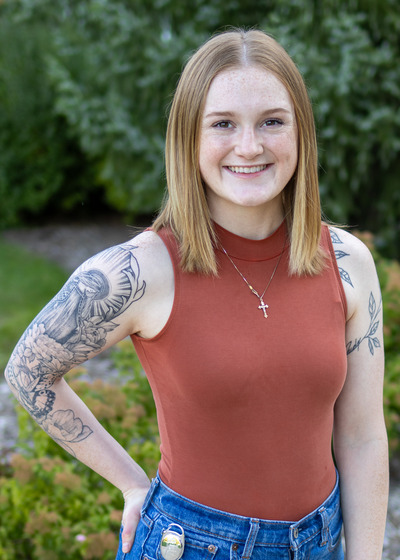Kendall Mara
Kendall Mara is an MGI doctoral student in the Dodd Lab. These are her answers to the Micro Biography questions:

How and when did you become interested in the field(s) of microbiology, genetics, and/or immunology?
I became particularly interested in microbiology during my junior year of high school when I had the opportunity to participate in a “mini-medical school” camp hosted by the University of Missouri at Columbia, which ultimately influenced my decision to choose that university over my hometown college! It was a really great experience where we got to practice stitches on pigs’ feet, tour the cadaver lab, and even solve a case study. Throughout the process, I learned that while I may not want to go to medical school (due to learning I am not built for dealing with tissue, as I almost passed out stitching up said pigs' feet), I was very interested in infectious disease. This camp led me to choose microbiology as my undergraduate major, and after that I was hooked!
Were there any particular people or events who were influential in your journey?
Many people and experiences played significant roles in my journey, including the mini-med camp. However, I think one of the most influential things was growing up on a farm. From a young age, I was really hands on with farm animals, and you could usually find me outside with chickens, turkeys, bunnies, goats, and more. I was deeply affected when an animal got sick or passed, and witnessing this sparked my interest in understanding the organisms that cause disease in animals. While I’ve realized that I’m not suited for human or animal medicine, this experience has driven my passion for furthering our knowledge of these organisms and has shaped my purpose as a scientist.
How did you come to be a part of this department?
My undergraduate research primarily focused on vector-borne disease, with an emphasis on ticks. I had a feeling that I might want to make a switch to another field in microbiology, but I wanted to go to a school that had vector research just in case I wanted to stay with that. That really narrowed the pool of programs I wanted to apply to, and initially MSU wasn’t on my radar. However, my sister, who graduated from MSU’s DO program in 2023, insisted that I apply here. I begrudgingly obliged and found that MSU was definitely the best option from my offers, so ultimately, she knew best (as older sisters typically do).
What is your main role / research area right now and why is it important?
My research focuses on antimicrobial resistance in Mycoplasma bovis, a highly contagious bacterial pathogen that can infect several body sites in cattle to cause arthritis, mastitis, or mild to severe respiratory disease. There are many barriers to preventing and treating infections caused by M. bovis including the lack of a commercially available vaccine and intrinsic resistance to several antibiotics. Additionally, other research groups have uncovered evidence that suggests there is emerging antibiotic resistance to the already limited number of efficacious antibiotics. Antimicrobial susceptibility testing (AST) is not offered by many veterinary diagnostic laboratories because of its challenging growth requirements and the lack of a standardized AST method. This is due to the failure to find an accurate, rapid, and reproducible way to enumerate these bacteria, which is the first step in any AST method, since it ensures consistency and subsequent accurate interpretation across assays. My goal is to standardize an AST method for M. bovis by using impedance flow cytometry to enumerate bacteria, which has never been used for this purpose before. This approach has potential for adaptation to other veterinary Mycoplasmas and will be a large step forward in improving antibiotic stewardship.
How do you see your role / research evolving?
A good next step for my project will be to explore antimicrobial resistance in companion animal Mycoplasmas, since current veterinary Mycoplasma research focuses heavily on food animals and not much has been done for the cats and dogs. However, there’s still so much that needs to be done to address M. bovis, specifically how it’s able to persist in the mammary glands of dairy cattle even with rigorous treatment. Regardless of what direction my research goes, I’m excited to see where it takes me and the field of mycoplasmology in general!
What types of activities are you involved in outside of work / research?
Outside of work, I enjoy staying active by lifting weights, playing pickleball, and walking my two dogs. Said dogs keep me pretty busy as well, usually using their mind control by way of puppy dog eyes to keep me at home in an endless game of fetch and tug (one arm/dog dedicated to fetch and the other arm/dog for tug). I also love thrifting, antiquing, and scouring Facebook Marketplace for things I will probably never buy but really enjoy admiring.
What is next for you?
In the coming year I’ll be gearing up for my preliminary exam! While the thought of it terrifies me, I’m really excited to keep moving forward with my research and dedicate more time to it.
What do you see as your current career trajectory?
At this point in my education, my career trajectory changes every few months! Being in graduate school has surprisingly turned me more towards a possibility in academia but since I conduct my research in a diagnostic lab, I’ve come to appreciate assay development and have become aware of the need to improve and create new techniques for diagnostics. Right now, I lean towards diagnostics, but I guess we’ll see where the rest of my PhD takes me!